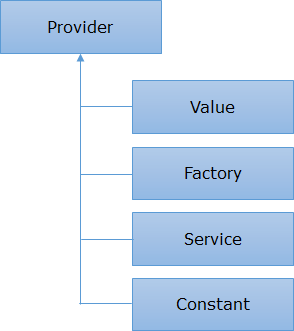About services, factories, and providers in AngularJS AngularJS 16.07.2015

AngularJS module objects have five functions that declare services to the dependency injector. The three most common ways are the service(), factory(), and provider() functions.
The factory() Function
The factory() function is the simplest and most common way to create a service in AngularJS. Fundamentally, a factory is a function that the dependency injector uses to create an instance of the service. Syntactically, a factory looks like this
app.factory('myService', function() {
var myService = {};
// define myService
return myService;
});
The return value of the given function is injected into any function that lists myService as a dependency. For example:
app.factory('myService', function() {
var myService = {
foo: "bar"
};
return myService;
});
app.controller('MyCtrl', function(myService) {
console.log(myService.foo);
});
A factory can take parameters through dependency injection, so you can reuse services like $http (or even your own custom services) in your services.
Services are always singletons in the sense that there is one instance of the service that’s shared between all controllers and services that use it.
The service() Function
The redundantly named service() function is another convenient way of creating a service. As you’ll see, the service() function offers essentially the same functionality as the factory() function, with a few academic differences.
The difference between the service() function and the factory() function is that, whereas the factory() function requires you to construct an object in your code and return it, the function you pass to the service() function is executed using JavaScript’s new operator. In other words, when using the service() function, you don’t have to explicitly construct and return a new object; you simply need to attach properties to this. Here’s how using the service() function looks in real JavaScript
app.service('myService', function() {
this.foo = "bar";
});
app.controller('MyCtrl', function(myService) {
console.log(myService.foo);
});
The service() function is often more succinct. However, the this keyword is confusing and difficult to use properly in JavaScript, and many developers avoid using it out of principle.
functions.
The factory() and service() functions create services the same way every time, but providers effectively enable you to switch which factory function the dependency injector uses to construct a given function.
The provider() Function
The provider() function is the most expressive way to create services, and, correspondingly, the most complex. At a high level, the provider() function lets you determine which service to register based on application-wide configuration. As a matter of fact, under the hood, the factory() and service() functions you just learned about are implemented as syntactic sugar on top of the provider() function. For most cases, the provider() function is overkill, and you often build out an entire AngularJS app without creating a single provider.
The primary purpose of the config() function is to configure the application’s providers so the application uses the correct services. The contents of a config() function are typically called a configuration block. AngularJS runs your configuration blocks in order before any controllers, services, or directives are instantiated.
Syntactically, a configuration block looks like this:
app.config(function($httpProvider) {
// use $httpProvider here
});
Note that configuration blocks are the only place where you can access providers through dependency injection rather than the services themselves.
Quote
Categories
- Android
- AngularJS
- Databases
- Development
- Django
- iOS
- Java
- JavaScript
- LaTex
- Linux
- Meteor JS
- Python
- Science
Archive ↓
- September 2024
- December 2023
- November 2023
- October 2023
- March 2022
- February 2022
- January 2022
- July 2021
- June 2021
- May 2021
- April 2021
- August 2020
- July 2020
- May 2020
- April 2020
- March 2020
- February 2020
- January 2020
- December 2019
- November 2019
- October 2019
- September 2019
- August 2019
- July 2019
- February 2019
- January 2019
- December 2018
- November 2018
- August 2018
- July 2018
- June 2018
- May 2018
- April 2018
- March 2018
- February 2018
- January 2018
- December 2017
- November 2017
- October 2017
- September 2017
- August 2017
- July 2017
- June 2017
- May 2017
- April 2017
- March 2017
- February 2017
- January 2017
- December 2016
- November 2016
- October 2016
- September 2016
- August 2016
- July 2016
- June 2016
- May 2016
- April 2016
- March 2016
- February 2016
- January 2016
- December 2015
- November 2015
- October 2015
- September 2015
- August 2015
- July 2015
- June 2015
- February 2015
- January 2015
- December 2014
- November 2014
- October 2014
- September 2014
- August 2014
- July 2014
- June 2014
- May 2014
- April 2014
- March 2014
- February 2014
- January 2014
- December 2013
- November 2013
- October 2013